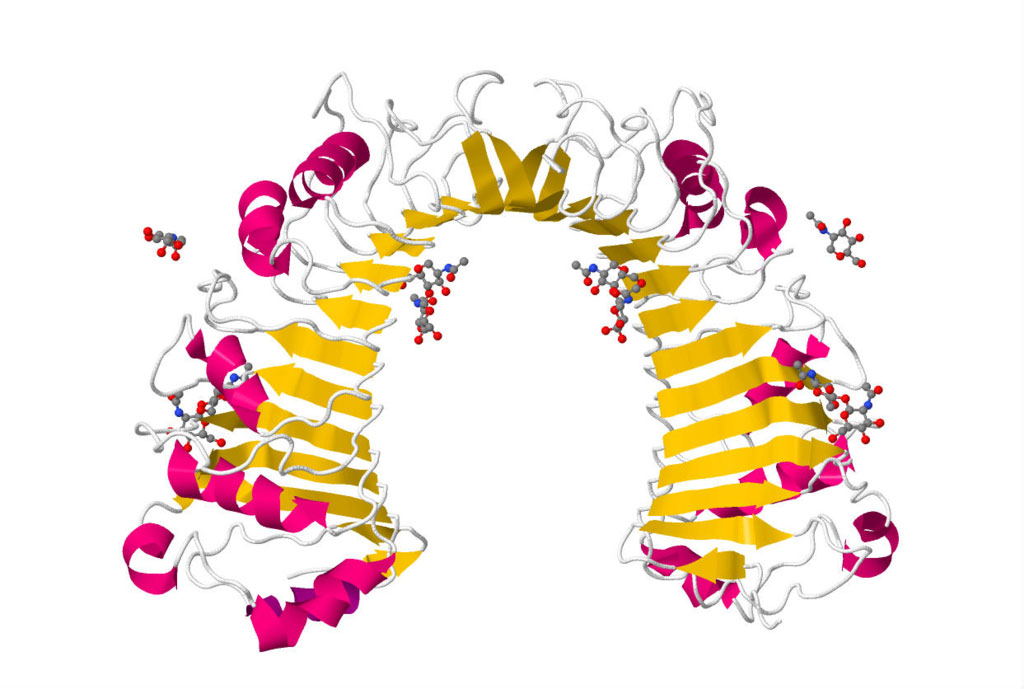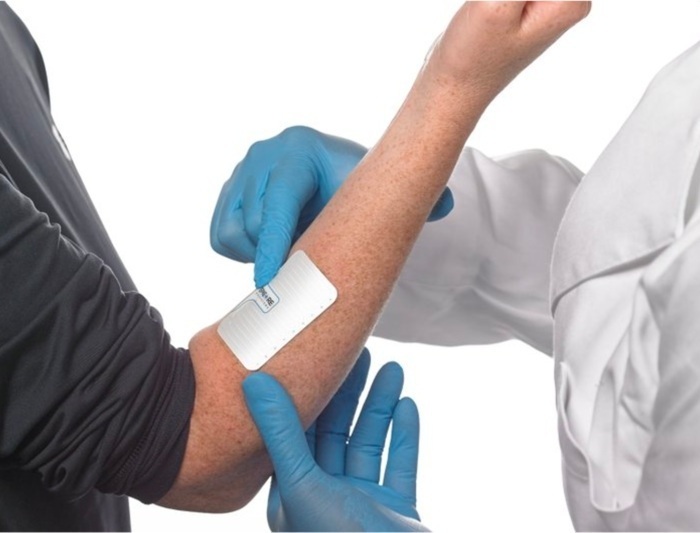Novel Biomarker Predicts Dementia Risk
|
By LabMedica International staff writers Posted on 18 Dec 2019 |

Image: Crystal structure of CD14 protein and its implications for lipopolysaccharide signaling (Photo courtesy of Wikimedia Commons)
A new biomarker related to brain atrophy, cognitive decline, and dementia was described in a recently published paper.
Investigators at the University of Texas Health Science Center at San Antonio (USA) compared risk of dementia to levels of the biomarker sCD14 in 1,588 participants from the Framingham Heart Study and 3,129 participants from the Cardiovascular Health Study.
The protein encoded by the CD14 gene is a surface antigen that is preferentially expressed on monocytes and macrophages. It cooperates with other proteins to mediate the innate immune response to bacterial lipopolysaccharide. CD14 exists in two forms, one anchored to the membrane by a glycosylphosphatidylinositol tail (mCD14), the other a soluble form (sCD14). Soluble CD14 either appears after shedding of mCD14 or is directly secreted from intracellular vesicles.
Investigators measured levels of plasma sCD14 in samples of participants’ blood at the time they enrolled in the study. In the Framingham group, brain MRI and cognitive testing were performed within one year after measurement of sCD14. A second round of tests was performed after seven years. Surveillance for dementia was conducted over an average of nine years. In the Cardiovascular Health Study group, the first brain MRI was obtained three to four years after enrollment and a second round five years later.
Mean age of the members of the Framingham group was 69 ± 6 years, 47% male (131 incident events), and the mean age of the Cardiovascular Health Study group was 72 ± 5 years, 41% male (724 incident events). Meta-analysis across the two cohorts showed that each SD unit increase in sCD14 was associated with a 12% increase in the risk of incident dementia following adjustments for age, sex, APOE epsilon4 status, and vascular risk factors.
"We have strong reason to believe that sCD14 can be a useful biomarker to assess a person's risk of cognitive decline and dementia," said contributing author Dr. Sudha Seshadri, professor of neurology at the University of Texas Health Science Center at San Antonio. "The most exciting part is that we could assess this risk in advance, when there is ample time to intervene and change the course of a person's life."
The study was published in the December 9, 2019, online edition of the journal Neurology.
Related Links:
University of Texas Health Science Center at San Antonio
Investigators at the University of Texas Health Science Center at San Antonio (USA) compared risk of dementia to levels of the biomarker sCD14 in 1,588 participants from the Framingham Heart Study and 3,129 participants from the Cardiovascular Health Study.
The protein encoded by the CD14 gene is a surface antigen that is preferentially expressed on monocytes and macrophages. It cooperates with other proteins to mediate the innate immune response to bacterial lipopolysaccharide. CD14 exists in two forms, one anchored to the membrane by a glycosylphosphatidylinositol tail (mCD14), the other a soluble form (sCD14). Soluble CD14 either appears after shedding of mCD14 or is directly secreted from intracellular vesicles.
Investigators measured levels of plasma sCD14 in samples of participants’ blood at the time they enrolled in the study. In the Framingham group, brain MRI and cognitive testing were performed within one year after measurement of sCD14. A second round of tests was performed after seven years. Surveillance for dementia was conducted over an average of nine years. In the Cardiovascular Health Study group, the first brain MRI was obtained three to four years after enrollment and a second round five years later.
Mean age of the members of the Framingham group was 69 ± 6 years, 47% male (131 incident events), and the mean age of the Cardiovascular Health Study group was 72 ± 5 years, 41% male (724 incident events). Meta-analysis across the two cohorts showed that each SD unit increase in sCD14 was associated with a 12% increase in the risk of incident dementia following adjustments for age, sex, APOE epsilon4 status, and vascular risk factors.
"We have strong reason to believe that sCD14 can be a useful biomarker to assess a person's risk of cognitive decline and dementia," said contributing author Dr. Sudha Seshadri, professor of neurology at the University of Texas Health Science Center at San Antonio. "The most exciting part is that we could assess this risk in advance, when there is ample time to intervene and change the course of a person's life."
The study was published in the December 9, 2019, online edition of the journal Neurology.
Related Links:
University of Texas Health Science Center at San Antonio
Latest Molecular Diagnostics News
- Routine Blood Draws Could Detect Epigenetic Biomarkers for Predicting Cardiovascular Disease Risk
- Single Cell RNA Sequencing Could Enable Non-Invasive Blood Disorder Diagnosis
- Blood Test Identifies HPV-Associated Head and Neck Cancers 10 Years Before Symptoms
- Giant DNA Elements Discovered in Mouth Could Impact Oral Health
- Simple Blood Test Spots Disease Through Metabolic Distortion
- Simple Blood Test Could Streamline Early Alzheimer's Detection
- Unique Microbial Fingerprint to Improve Diagnosis of Colorectal Cancer
- ELISA-Based Test Uses Gynecologic Fluids to Detect Endometrial Cancer
- Comprehensive Tumor Profiling Kit Decentralizes and Standardizes Oncology Testing
- Automated Syndromic Testing System Combines Unparalleled Throughput with Simple Workflow
- Simple Urine Test Assesses Risk of Kidney Cancer Recurrence at Early Stage
- Molecular Map Reveals Previously Hidden Connections Between Diseases
- Novel Urine-Based Test Detects Prostate Cancers
- MRD Testing Can Identify Breast Cancer Survivors at Higher Risk of Recurrence
- Cytoskeletal Protein Linked to Cervical Cancer Growth Paves Way for Precise Diagnostic Tools
- Molecular Allergy Chip Detects Allergic Asthma in Individual Patients
Channels
Clinical Chemistry
view channel
Gold Nanoparticles to Improve Accuracy of Ovarian Cancer Diagnosis
Ovarian cancer is considered one of the deadliest cancers, in part because it rarely shows clear symptoms in its early stages, and diagnosis is often complex. Current approaches make it difficult to accurately... Read more
Simultaneous Cell Isolation Technology Improves Cancer Diagnostic Accuracy
Accurate cancer diagnosis remains a challenge, as liquid biopsy techniques often fail to capture the complexity of tumor biology. Traditional systems for isolating circulating tumor cells (CTCs) vary in... Read moreHematology
view channel
Pioneering Model Measures Radiation Exposure in Blood for Precise Cancer Treatments
Scientists have long focused on protecting organs near tumors during radiotherapy, but blood — a vital, circulating tissue — has largely been excluded from dose calculations. Each blood cell passing through... Read more
Platelets Could Improve Early and Minimally Invasive Detection of Cancer
Platelets are widely recognized for their role in blood clotting and scab formation, but they also play a crucial role in immune defense by detecting pathogens and recruiting immune cells.... Read more
Portable and Disposable Device Obtains Platelet-Rich Plasma Without Complex Equipment
Platelet-rich plasma (PRP) plays a crucial role in regenerative medicine due to its ability to accelerate healing and repair tissue. However, obtaining PRP traditionally requires expensive centrifugation... Read moreImmunology
view channel
Companion Diagnostic Test Identifies HER2-Ultralow Breast Cancer and Biliary Tract Cancer Patients
Breast cancer is the most common cancer in Europe, with more than 564,000 new cases and 145,000 deaths annually. Metastatic breast cancer is rising in younger populations and remains the leading cause... Read more
Novel Multiplex Assay Supports Diagnosis of Autoimmune Vasculitis
Autoimmune vasculitis and related conditions are difficult to diagnose quickly and accurately, often requiring multiple tests to confirm the presence of specific autoantibodies. Traditional methods can... Read more
Blood Test Predicts Immunotherapy Efficacy in Triple-Negative Breast Cancer
Triple-negative breast cancer (TNBC) is an aggressive subtype lacking targeted therapies, making immunotherapy a promising yet unpredictable option. Current biomarkers such as PD-L1 expression or tumor... Read more
Simple Genetic Testing Could Predict Treatment Success in Multiple Sclerosis Patients
Multiple sclerosis (MS) patients starting therapy often face a choice between interferon beta and glatiramer acetate, two equally established and well-tolerated first-line treatments. Until now, the decision... Read moreMicrobiology
view channel
Microfluidic Platform Assesses Neutrophil Function in Sepsis Patients
Sepsis arises from infection and immune dysregulation, with neutrophils playing a central role in its progression. However, current clinical tools are unable to both isolate these cells and assess their... Read moreNew Diagnostic Method Confirms Sepsis Infections Earlier
Sepsis remains one of the most dangerous medical emergencies, often progressing rapidly and becoming fatal without timely intervention. Each hour of delayed treatment in septic shock reduces patient survival... Read more
New Markers Could Predict Risk of Severe Chlamydia Infection
Chlamydia trachomatis is a common sexually transmitted infection that can cause pelvic inflammatory disease, infertility, and other reproductive complications when it spreads to the upper genital tract.... Read more
Portable Spectroscopy Rapidly and Noninvasively Detects Bacterial Species in Vaginal Fluid
Vaginal health depends on maintaining a balanced microbiome, particularly certain Lactobacillus species. Disruption of this balance, known as dysbiosis, can increase risks of infection, pregnancy complications,... Read morePathology
view channelAccurate Pathological Analysis Improves Treatment Outcomes for Adult Fibrosarcoma
Adult fibrosarcoma is a rare and highly aggressive malignancy that develops in connective tissue and often affects the limbs, trunk, or head and neck region. Diagnosis is complex because tumors can mimic... Read more
Clinicopathologic Study Supports Exclusion of Cervical Serous Carcinoma from WHO Classification
High-grade serous carcinoma is a rare diagnosis in cervical biopsies and can be difficult to distinguish from other tumor types. Cervical serous carcinoma is no longer recognized as a primary cervical... Read moreTechnology
view channel
Coral-Inspired Capsule Samples Hidden Bacteria from Small Intestine
The gut microbiome has been linked to conditions ranging from immune disorders to mental health, yet conventional stool tests often fail to capture bacterial populations in the small intestine.... Read more
Rapid Diagnostic Technology Utilizes Breath Samples to Detect Lower Respiratory Tract Infections
Respiratory tract infections (LRTIs) are leading causes of illness and death worldwide, particularly among vulnerable populations such as the elderly, young children, and those with compromised immune systems.... Read moreIndustry
view channel
Werfen and VolitionRx Partner to Advance Diagnostic Testing for Antiphospholipid Syndrome
Antiphospholipid syndrome (APS) is a rare autoimmune disorder that causes the immune system to produce abnormal antibodies, making the blood “stickier” than normal. This condition increases the risk of... Read more



















